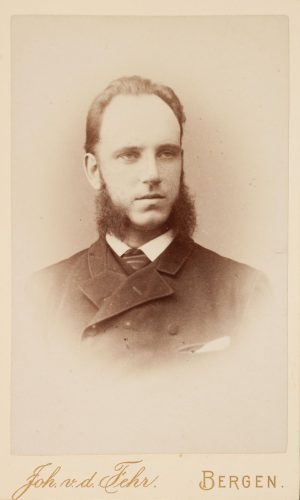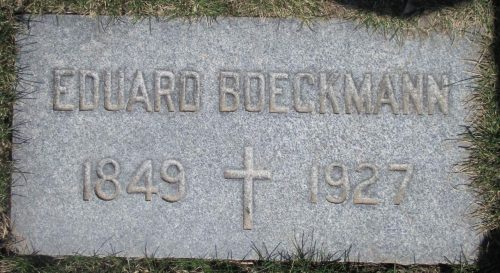Eduard Bøckmann (1849-1927)
Bøckmann was assistant physician at Lungegaard Hospital from 1875 to 1886 and helped to establish the journal Medicinsk Revue (1884–1939) together with Gerhard Armauer Hansen and Klaus Hanssen. In 1887, he hosted Armauer Hansen’s research stay in the USA, which he also financed.

Eduard Bøckmann was born in Østre Toten and received his medical degree in 1874. Following study trips to several eye clinics in Europe, he set up practice as Bergen’s first ophthalmologist. He worked as a doctor in Bergen until 1886, before settling in St. Paul in Minnesota.
In 1875, he took over the position of assistant physician at Lungegaard Hospital, when Hansen became Chief Medical Officer for Leprosy. This also meant that he served as acting head physician when Danielssen was away. In 1880–1881, he conducted field research on a corneal disorder typical in leprosy patients at Pleiestiftelsen Hospital, and, in 1882, he completed his doctoral dissertation.
Eduard Bøckmann was very active in the collegiate community in Bergen. He breathed life into the dormant society Bergens Medicinske Selskap, founded in 1831 by Christian Wisbech. It was also on his initiative that the society launched the journal Medicinsk Revue in 1884.
Bøckmann supported Armauer Hansen’s travels around the USA to find descendants of Norwegian leprosy patients, and these studies supported the theory that leprosy was an infectious disease. In 1886, Hansen had applied to the Norwegian Parliament for a travel grant to study leprosy among the expatriate Norwegian population in the USA, where he wanted to investigate the offspring of 200 people with leprosy who had emigrated. After his application was rejected, Hansen received a letter from Bøckmann, which is said to have read as follows: ‘I am pleased that you received not a penny from the Storting,’ and went on to say that it would be a pleasure for him to pay for Hansen’s trip. Hansen travelled to St. Paul in January 1887 and stayed there over the winter, where he worked in Bøckmann’s office and laboratory.
Eduard Bøckman invented a sterilisation chamber that left equipment dry after steaming, which he presented at a meeting of physicians in Trondheim in 1891. In 1901, he launched a new, improved medical sewing thread made from animal gut, which was in production until 1959.
Bøckmann remained in the USA for the rest of his life, working as a surgeon and ophthalmologist, especially among Norwegian settlers in the northwestern states. He did, however, serve as assistant surgeon general in the Spanish-American War. On his initiative, a hospital for Norwegian immigrants was built in St. Paul in 1902. Bøckmann was appointed Knight of the Order of St. Olav in 1907 and Commander in 1911 for his work with expatriate Norwegians.

https://www.findagrave.com/memorial/188913783/eduard-boeckmann



